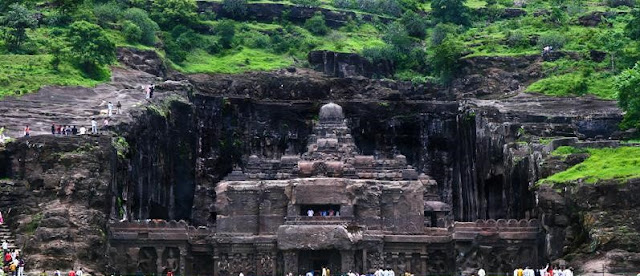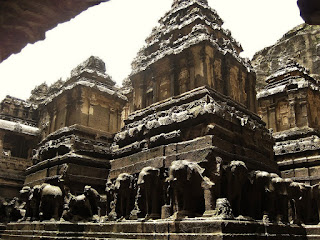The ancient Indian name for Ellora was
Verul Leni. Even now the local people refer to this place as verul. But Ellora
was originally known as Elur or Elapura in ancient days since it is located near the Elaganga
river, which originates from the near by hills. Between the 6th and
11th centuries, armies of planners, architects, sculptors, smiths
and artists were engaged in cutting the basalt lava rock, which makes up the
hills, into 34 caves.
Kailasanatha or Manikesvara
The Kailasa (Kailasanatha) temple is one of the
largest rock-cut ancient Hindu temples, The Kailasa temple (Cave 16) is one of
the 34 cave temples and monasteries known collectively as the Ellora Caves. What
makes this ancient structure a staggering architectural marvel is
that it is built by carving a mountain, from a single Rock, of the Charanandri
hills at a village named Ellora, Maharashtra.
The largest monolithic sculpture in the world carved
out of one single rock, it is considered one of the most remarkable cave
temples in India because of its size, architecture and sculptural treatment.
Kailasanatha is mentioned as
Manakeshvara in medieval literature. The Kailasa temple lacks a detailed
inscription, but it is clear that it was commissioned by a Rashtrakuta ruler.
Its construction is generally attributed to the Rashtrakuta king Krishna I
(Krishnaraja), based on two epigraphs. The Baroda copper plate issued in 812-13
CE at a place called Siddhamshi in Gujarat by Karka Suvarnavarsha (Rashtrakuta
King) mentions Krishnaraja as the patron of Kailasanatha temple (mentions a
Shiva temple) at Elapura (Ellora). It states that the king constructed a temple
so wondrous that even the gods and the architect were astonished. Based on the
inscription most scholars believe that this is a reference to the Kailasa
temple at Elora (by Bhandarkar 1927). This copper plate and the Kadamba grant
of Govinda Prabhutavarsha, another Rashtrakuta king, attribute the creation of
this monolith to Krishnaraja I.
Kailasa temple features the use of multiple distinct
architectural and sculptural styles. The temple architecture shows traces of
Pallava and Chalukya styles. This, combined with its relatively large size, has
led some scholars to believe that its construction spanned the reigns of
multiple kings.
It has many resemblances in style and
plan with the Virupaksha temple at Pattadakal, but is twice the size and
sculpted out of the rock instead of being built with blocks.
The Kailasa Temple is notable for its vertical
excavation, carvers started at the top of the rock, and excavated downward. The
traditional methods were rigidly followed by the master architect which could
not have been achieved by excavating from the front.
A medieval Marathi legend(katha-kalpa-taru)
appears to refer to the construction of the Kailasa temple. The legend, gives
the reason for such a unique architectural approach. The local king suffered from
a debilitating disease. His queen prayed to Grishneswar (Shiva) at the local
temple to cure her husband. She vowed to construct a temple if her wish was
granted and promised to fast until she could see the Shikhara (top point) of
the temple. The king was cured and she requested him to start the building
immediately but all the architects declared that it would take months and even
years to build a temple complete with the Shikhara. Obviously the queen would
die of starvation before she saw it. Only one architect called Kokasa assured
the king that the queen would be able to see the Shikhara of the temple in a
week’s time. Hence He first cut a finial on top of the hill. the queen on
seeing it, believed that the entire temple had been completed and broke her
fast. that’s how the top to bottom excavation of the kailasa temple complex
began. The temple was named Manikeshwara after the queen. M. K. Dhavalikar (1982)
theorizes that Kokasa was indeed the chief architect of the Kailasa temple,
which may have been originally known as Manikeshwara. Some 11th-13th century
inscriptions from central India mention architects born in the illustrious
family of Kokasa.
M. K. Dhavalikar analyzed the architecture of the
temple, and pointed out that no major part of the monolithic temple appears to
have been an afterthought, architectural evidence suggests that the entire
temple was planned at the beginning. The main shrine is a very similar in style
to the Virupaksha Temple at Pattadakal, which itself is a replica of the
Kailasa temple at Kanchi. The Pattadakal Virupaksha Temple was commissioned by
the Chalukyas of Badami to commemorate their victory over the Pallavas, who had
constructed the Kailasa temple at Kanchi. According to the Virupaksha temple
inscriptions, the Chalukyas brought the Pallava artists to Pattadakal after
defeating the Pallavas. Dhavalikar theorizes that after defeating the
Chalukyas, Krishna must have been impressed by the Virupaksha Temple located in
their territory. As a result, he brought the sculptors and architects of the
Virupaksha Temple (including some Pallava artists) to his own territory, and
engaged them in the construction of the Kailasa temple at Ellora. If one
assumes that the architects of the Virupaksha temple helped construct the
Kailasa temple at Ellora, the construction of a massive temple during the reign
of a single monarch does not seem impossible. The architects already had a
blueprint and a prototype, which must have significantly reduced the effort
involved in constructing a new temple. Moreover, excavating a monolithic temple
would have actually involved less effort than transporting large stones to
build a new temple of similar size. Assuming that one person can cut around 4
cubic feet of rock every day, Dhavalikar estimated that 250 labourers would
have managed to construct the Kailasa temple at Ellora within 5.5 years. The
presence of non-Rashtrakuta styles in the temple can be attributed to the
involvement of Chalukya and Pallava artists.
Dhavalikar concluded that the major part
of the temple was completed during the reign of Krishna I. According to
Dhavalikar, the following components were completed by Krishna I. the main
shrine, its gateway, the nandi-mandapa, the lower-storey, the elephant-lion
frieze, the court elephants and the victory pillars. Dhavalikar admits that the
most important sculpture of the temple, which depicts Ravana shaking the
Kailasa mountain, appears to have been built after the main edifice. This
sculpture is considered as one of the finest pieces of Indian art, and it is
possible that the temple came to be known as Kailasa after it. Dhavalikar
theorizes that this sculpture was carved around 3 - 4 decades after the
completion of the main shrine, on the basis of its similarity to the tandava
sculpture in the Lankeshvar cave.
Dhavalikar attributes some other structures
in the temple complex to the later rulers. These include the Lankeshvar cave
and the shrine of the river goddesses (possibly constructed during the reign of
Govinda III). Dhavalikar further theorizes that the excavation of the
Dashavatara cave, which began during the reign of Dantidurga, was completed
during the reign of Krishna I. This explains the similarities between the sculptures
in the two caves.
Adhistana, the yajna mantapa, the annexes knownas
lankeshwar and peralanka and 3 galleries on the temple’s three sides might have
been the work of succeeding generations. According to Goetz, the 11th century
Paramara ruler Bhoja added a new layer
of paintings. Finally, Ahilyabai Holkar commissioned the last layer of paintings in the temple.
History is not clear in whose reign it
ended. However, if you look closely, you can see it is still unfinished in some
portions.
Also read : Mystery of Kailasanatha temple
Also read : Mystery of Kailasanatha temple











0 Comments